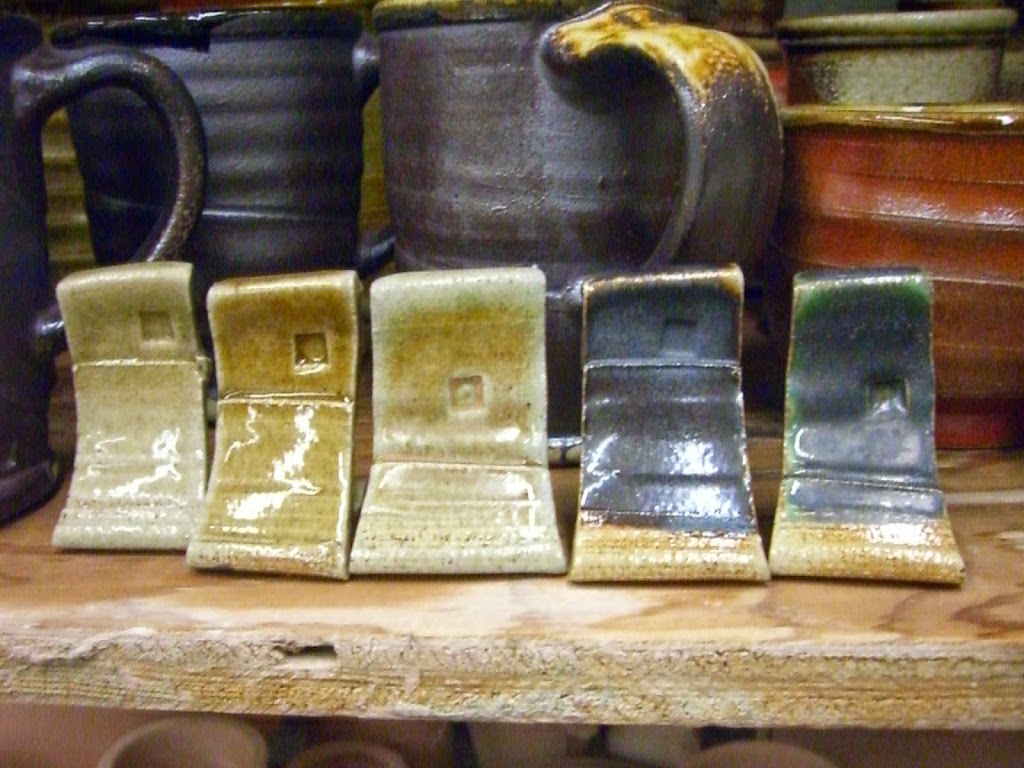 |
| Older test tiles for different soda fired glazes. |
I am quite happy with the glazes I use. Of course, if you know any artist, anything we might be happy with tends to change quite frequently and dramatically. But for now these glazes are very satisfactory to me and their visual quality seems long-lived.
Keep in mind I fire in a hot cone 10 reduction atmosphere with iron-bearing clay…usually with lots of grog.
American Shino:
50 Nepheline Syenite
25 Ball Clay
25 Spodumene
0-2 Soda Ash
I formulated this glaze by studying quite a few American potters’ shino recipes. I began by testing many recipes and noting both likes and dislikes of each glaze test. Noticing patterns, it became obvious to me that I really enjoyed a shino that included the ingredient Spodumene. BINGO! I also enjoy simple recipes with few ingredients the most, so the recipe came quite easily after the testing. Enjoy!
Notes:
- This is a cone 10 glaze that likes a hot firing.
- What I love about it: it fires from creamy white to dark orange, thick to thin; it pinholes beautifully where you trim; it has a wonderful feel; it doesn’t crawl.
- What I am unsatisfied with: It crazes a bit too much; it is too shiny; it doesn’t crawl :).
 |
| American Shino – One of my favorite bowls. |
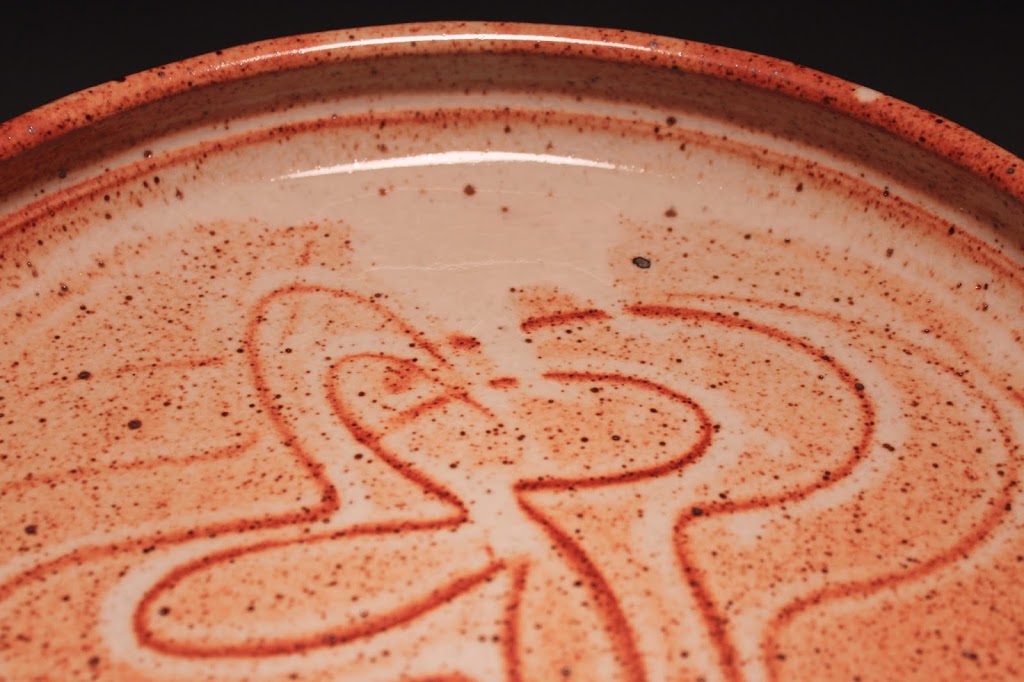 |
| American Shino – The variety of colors with this glaze are fantastic! Creamy whites, dark oranges. Mmmmm! |
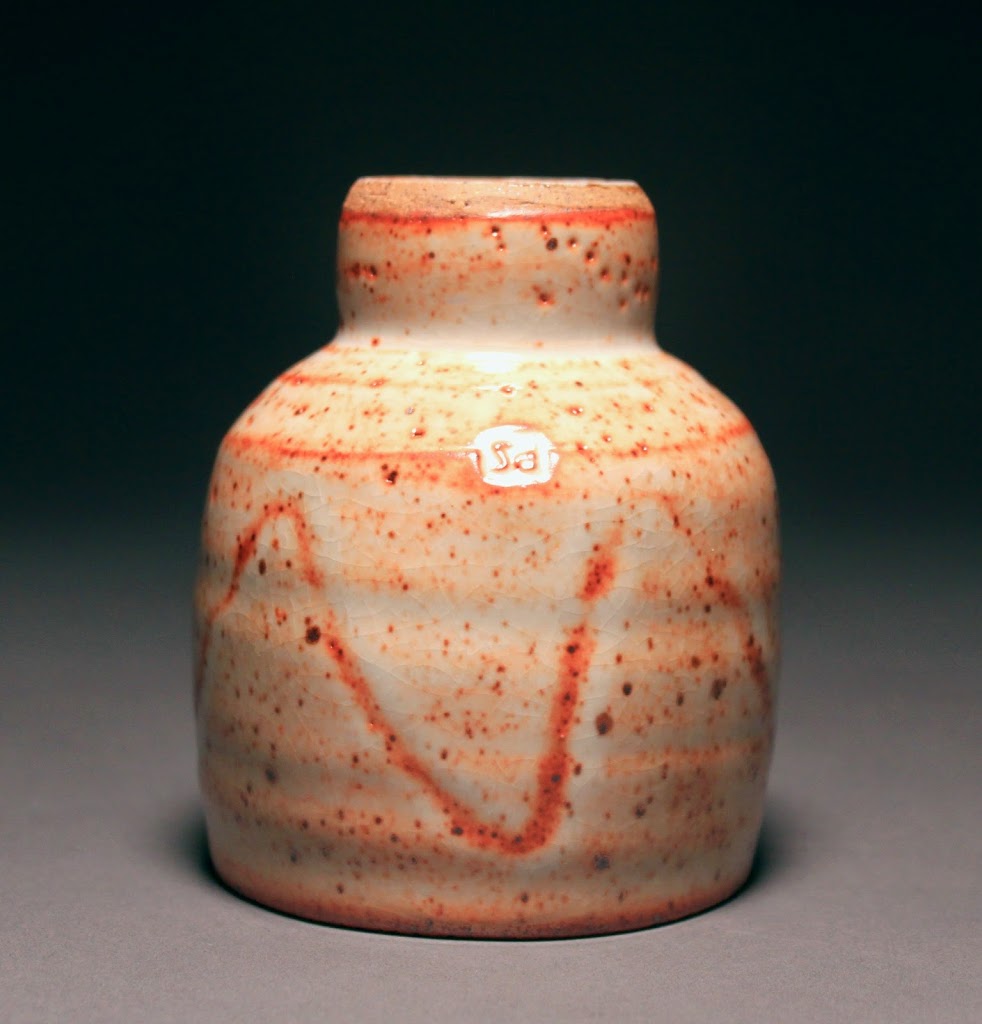 |
| American Shino – Notice the pinholes on the trimmed foot! Wowza! |
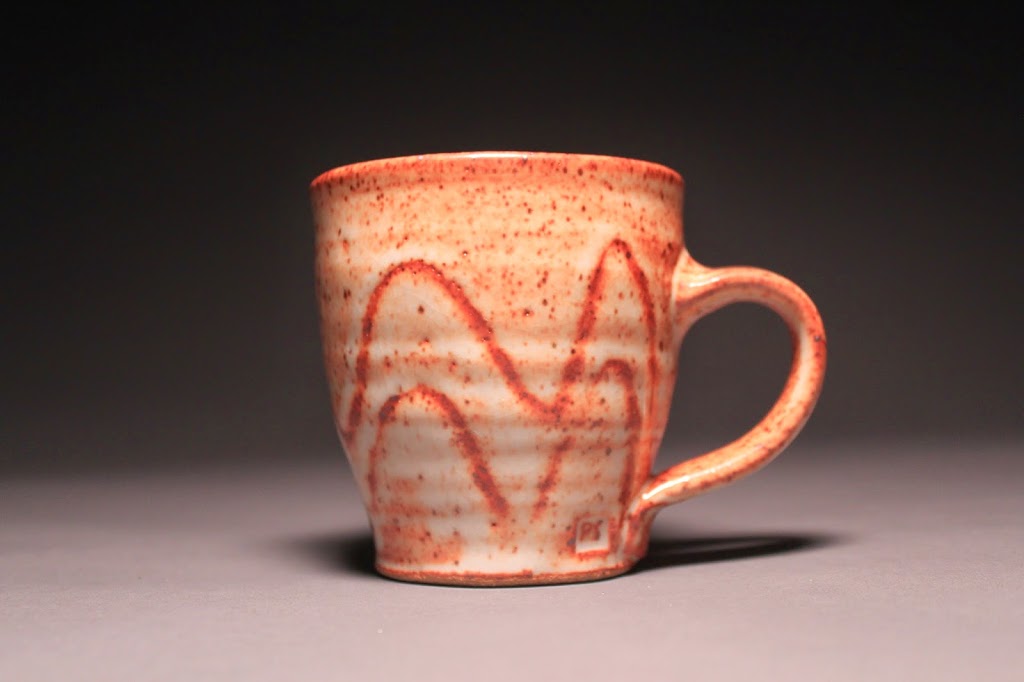 |
| American Shino – Finger swipes. Mountains and valleys. |
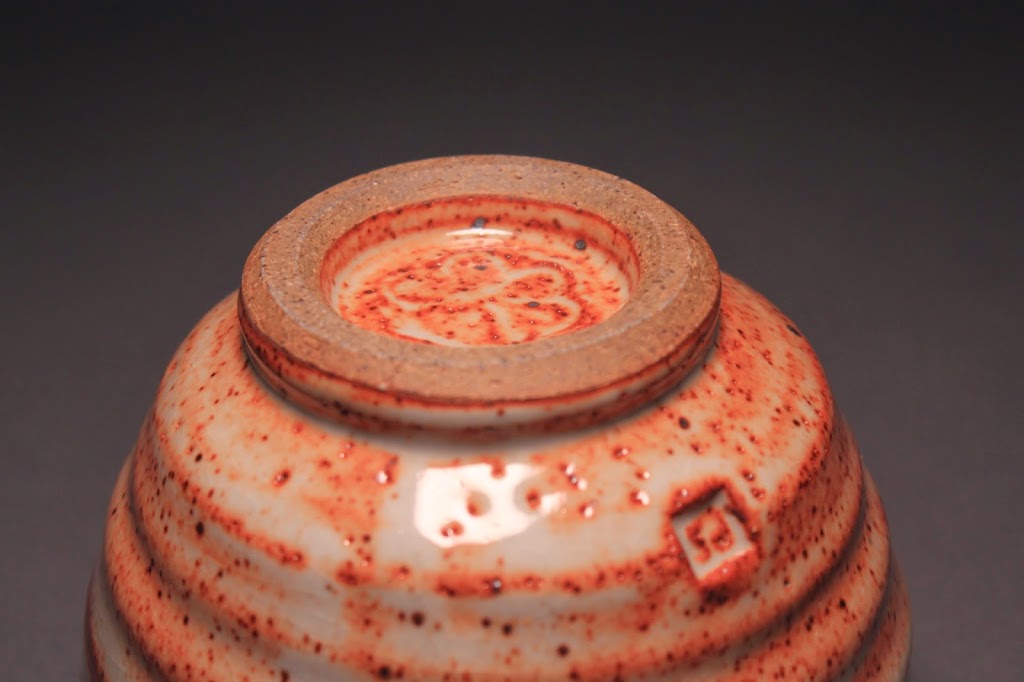 |
| American Shino – More sexy pinholes! |

Yellow Matte:
50 Nepheline Syenite
25 Epk
25 Whiting
As you can see, this is another simple recipe. It came from my love of Warren Mackenzie’s Mackenzie Grey Matte that is so prevalent. I simply substituted ingredients and it came out so very differently it is another glaze entirely.
Notes:
- This is a cone 10 reduction glaze
- What I love about it: The matte quality in this glaze is fantastic (if it works); the yellow color is also a very gorgeous soft earthy yellow; it fades to a black rocky color when thin.
- What I hate about it: The glaze settles VERY fast; the yellow color comes only if you’re lucky; it tends to have a greenish hue; if you dip too thin it comes out a washed out stony black color that is very rough to the touch (but I sand it down and it is actually really nice after being sanded!); it is inconsistent as of yet…needs some tweaking.
 |
| Yellow Matte: The variety of colors with this cup are wonderful, albeit difficult to see in this lighting. |
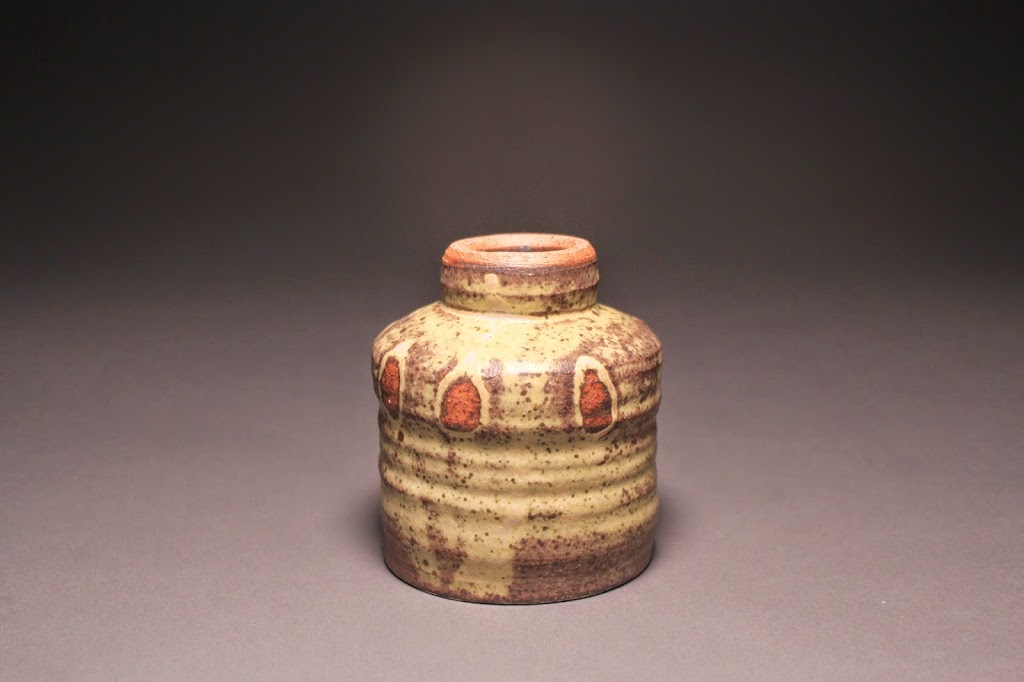 |
| Yellow Matte – The underside of the cup. I love feet 🙂 |
 |
| Yellow Matte – Notice how much drier this cup is compared to the top one. I had to sand this cup heavily inside and out to make it good for use. |
Mackenzie Grey:
50 Custer Feldspar
25 Whiting
25 EPK Kaolin
This is Warren Mackenzie’s famous matte grey glaze. An excellent, simple, and beautiful recipe that I formulated my Matte Yellow glaze from.
Notes:
- Cone 10 reduction glaze
- What I love about it: The grey is variable from thick to thin, going from brown to red to greenish to grey and sometimes even a wonderful sea blue; it’s a beautiful matte glaze that feels wonderful too; great for pouring over large pieces.
- What I don’t like about it: Not very durable–metal marks from silverware, acidic drinks left inside overnight will etch the glaze; crazes
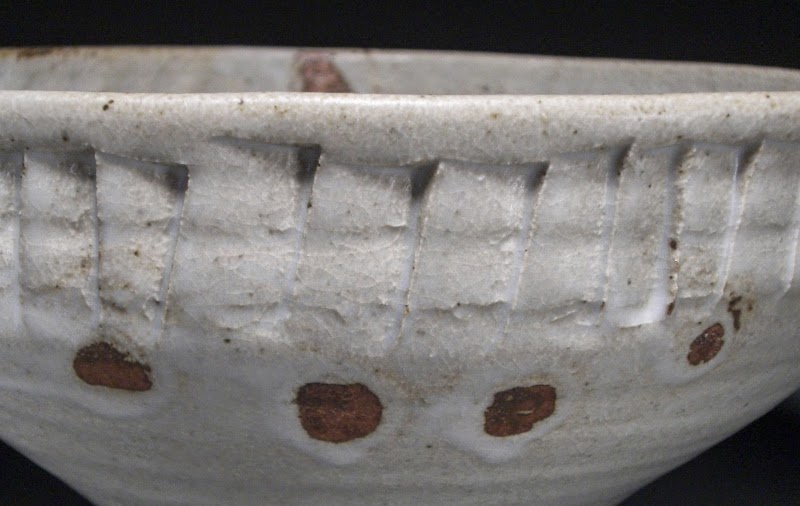 |
| Mackenzie Grey – A thicker application with finger marks. |
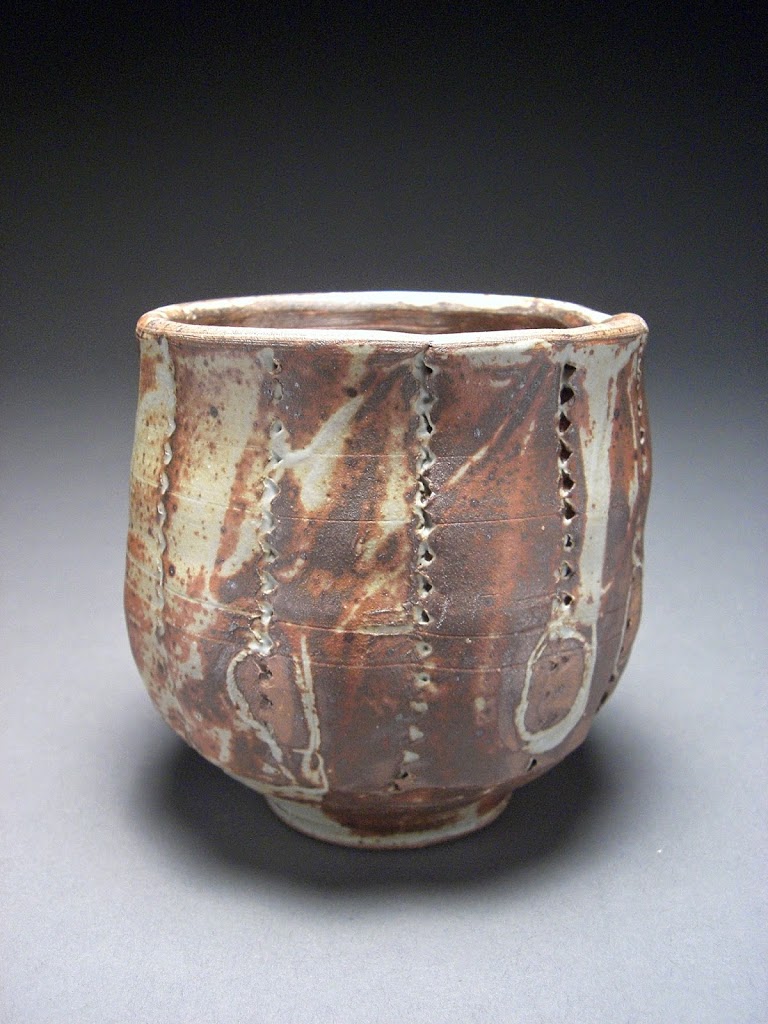 |
| Mackenzie Grey – Very thinly applied with finger dipping marks. Notice the reds coming through! |
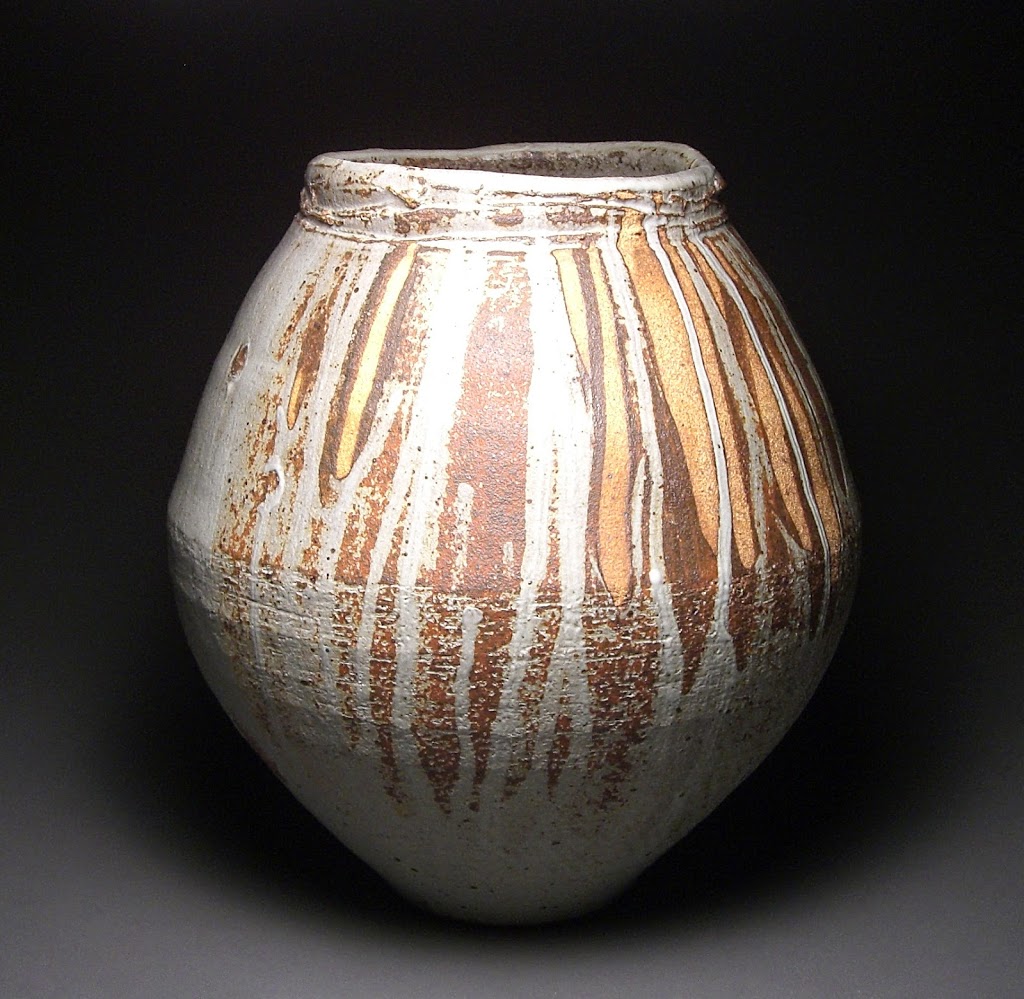 |
| Mackenzie Grey – This jar shows the glaze off really well. It has blues, greys, reds, browns and greens! |
Temmoku:
48.38 Custer Feldspar
20.14 Flint/Silica
11.64 Whiting
8.05 Red Iron Oxide
5.40 EPK Kaolin
2.24 Barium Carbonate
2.24 Zinc Oxide
This is a Bethel University classroom glaze graciously given to me by professor Kirk Freeman. Thanks Kirk! This temmoku is shiny and true black, and breaks to a beautiful coppery red/brown on edges and around handles.
Notes:
- This is a cone 10 reduction glaze.
- I dip my mugs one time only but for 20 seconds each. This ensures a nice thick coating that is not globby and gives a fantastic color.
- What I love: The temmoku has a beautiful black color and the copper breaks are AMAZING; it doesn’t run when you dip for 20 seconds, even at cone 10.5; it looks amazing with coffee inside a temmoku glazed mug.
- What I don’t like: the dried raw glaze can easily transfer from your fingertips to a white glazed pot without you noticing, and then you have red fingerprints on white pieces. But that’s about it!
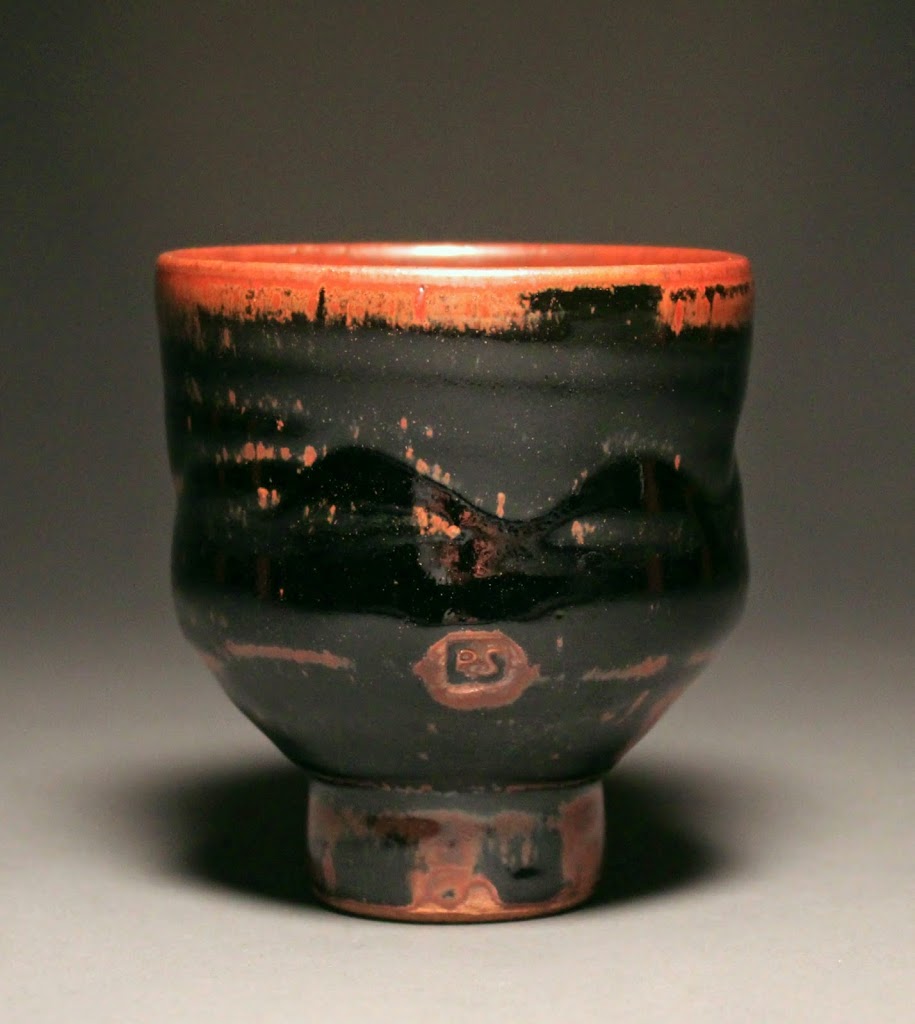 |
| Temmoku – Notice the wonderful coppery reds? Mmmmmm |
 |
| Temmoku – Notice it outlines my signature stamp VERY well. |
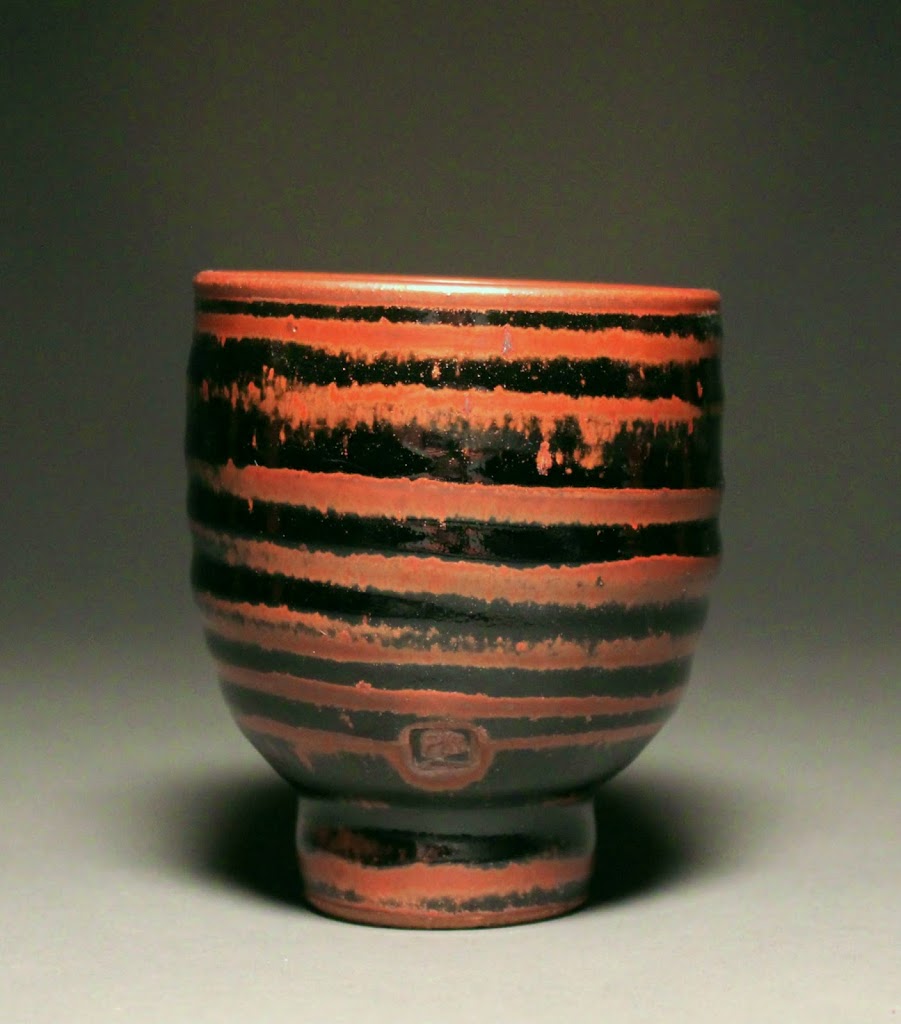 |
| Temmoku – The blacks are deep with this glaze, my young padawan. |
Chun Clear:
42.50 Custer Feldspar
26.55 Flint
8.85 Gerstley Borate
8.85 Dolomite
4.45 Barium Carbonate
2.65 Tin Oxide
1.75 EPK Kaolin
1.75 Zinc Oxide
This is a Bethel University class glaze graciously given to me by Kirk Freeman. Thanks Kirk!
A clear glaze with a slight blueish hue. Beautiful on porcelain and stoneware, but very different on both.
Notes:
- Cone 10 glaze reduction
- What I like: a beautiful glaze I love for porcelain mostly but can be really great with iron-rich clays too; crazes beautifully; very subtle and a lifetime of visual pleasure.
- What I don’t like: sometimes it scums a little bit on the inside of cups or bowls.
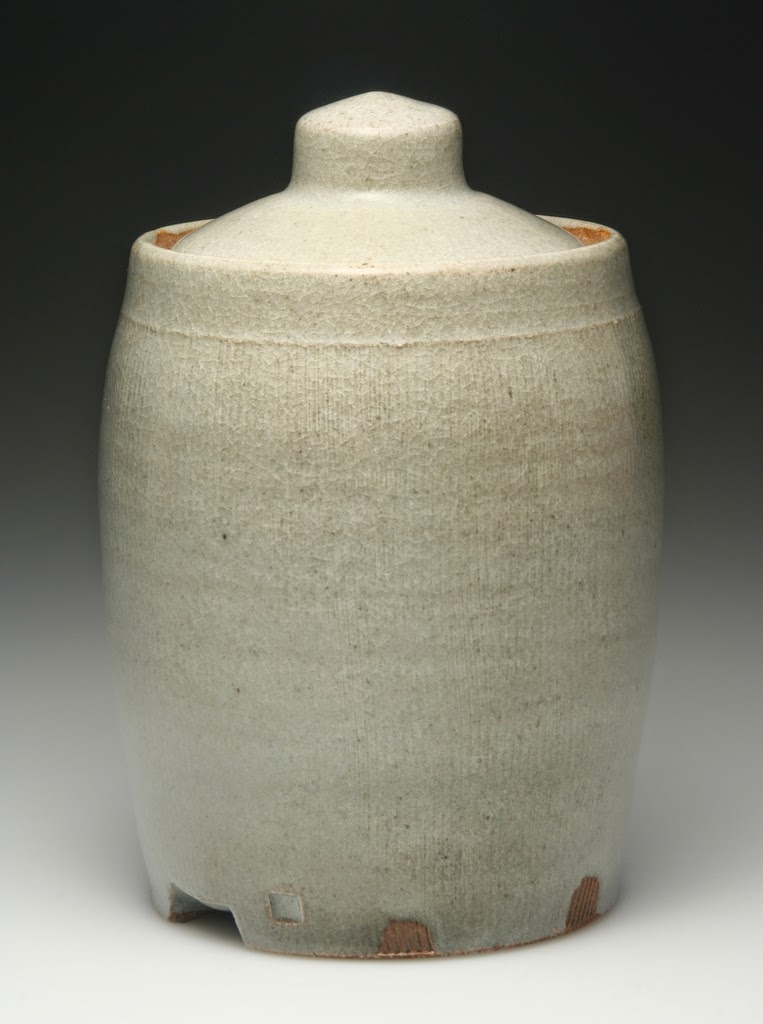 |
| Chun Clear – Over a buff stoneware, works beautifully with light surface decoration, in this case combing. |
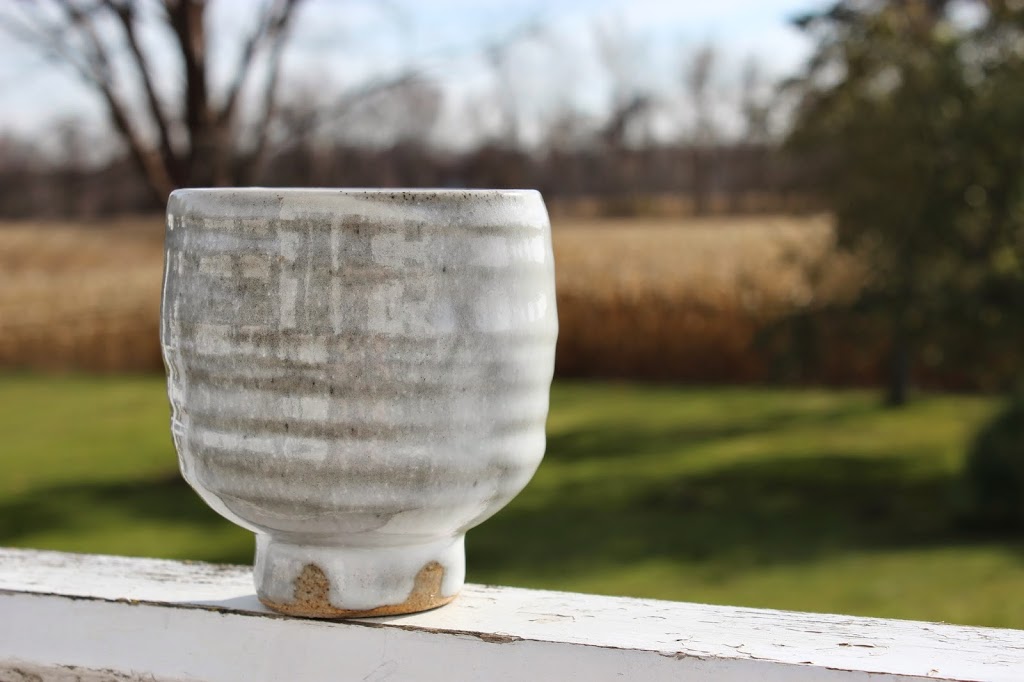 |
| Chun Clear – A slightly oxidized firing, this chun turned a milky white on the right side. Over fireclay stoneware. |
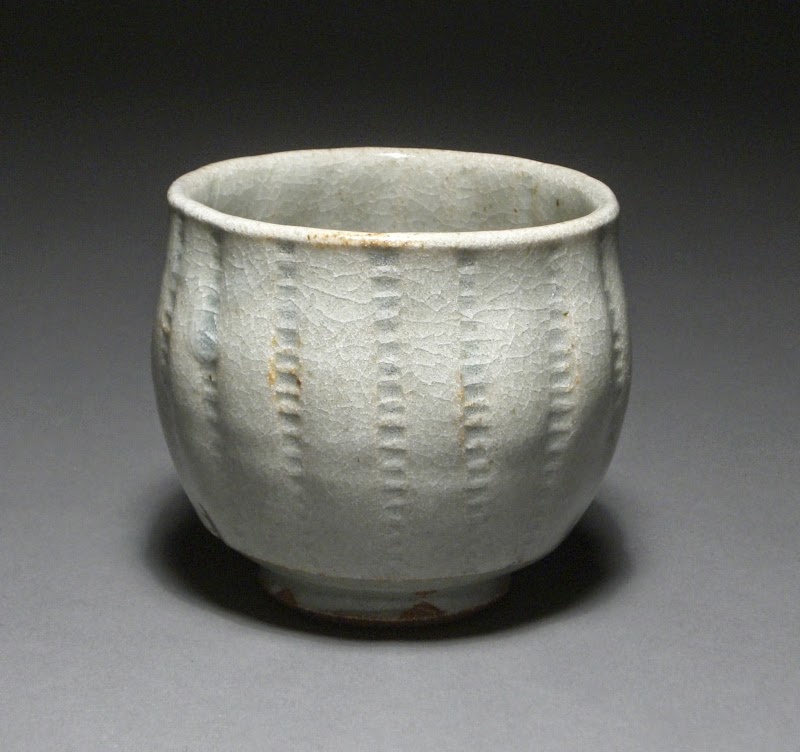 |
| Chun Clear – Over a buff stoneware, notice the fine crazing. |
Just so smitten with your work. I want all of those. Well, I have one of those, but I’d like all the others to join it. 🙂 Hope all is well in your world. Look forward to seeing your work again someday.
Thanks for the comment Lisa! I appreciate you!
Hey Phil, we had a batch of American Shino that I was told needed to be remixed. I gave it a go anyways and I really liked the results. Rather than coming out so orange, it was mostly a creamy white with slight orange breaks on the edges, pinholes, and it crazed. On some of the pieces, it carbon trapped quite nicely. Do you know what would have caused this so I can use it to my advantage again? (Too thick, substituting ingredients? I’ve noticed the American Shino turning into Carbon Trap, the Carbon Trap getting a Davis Shino look, and Davis Shino going black and gold.)
Hey Chris!
I am glad you like American Shino! It sounds like you applied the glaze quite thick, which would give it that creamy white color.
As for the carbon trapping, generally that is helped along with soda ash. If you add 5% soda ash to a test batch you might get more carbon trapping. However, please don’t mess with the 5 gallon class glaze, mix your own tests and whatnot. Thanks!
I hope this helps!
Hi Phil,
Thanks for sharing your recipes! My experience since I started throwing pottery a bit over a year ago has been mainly cone 6 stoneware, but I was recently offered the opportunity to help with an anagama firing and include some pieces. I came across your American Shino recipe in my search for cone 10 glazes and mixed up a batch to try on a few porcelain pieces . We’re loading the kiln today and tomorrow with firing for the next week. I’m curious/excited to see how it turns out in the anagama!
Hello Jay,
Thanks for saying hi! I am glad you happened upon the American Shino recipe! It’s my favorite, but I have never had the great opportunity to fire in a wood kiln with it. I hope the results are as favorable as they have been for me! I would love to see the results when they are finished, so please respond back if you have time!
Phil,
My apologies for not responding back much sooner. I had to wait about 6 months after the wood firing to get my pieces since it is a good 8-10 hour drive away and I wasn’t going to stay out of town an extra week waiting for the kiln to cool down after the firing.
Anyway, I didn’t get any of the orange/brown coming through on my pieces in the anagama. They were all porcelain and I dipped it on relatively thick. It was creamy white but that provided a great backdrop for the fly ash, etc that settled on them. The best of them are pretty nice! I can’t post photos in the comments or I’d share the results here.
I’ve since met a new potter friend who lives much closer and fires with wood as well so I’m excited to join him in some upcoming firings. Thanks!
Hi Phil
Great post. I always appreciate it when potters share recipes. I was wondering if you had a good yellow salt recipe. Mine works well right after mixing but after aging in the bucket it becomes much less attractive. Any help would be greatly appreciated
Hi Joe and thanks for posting! Glad to share the recipes. I know my old school has a recipe but it’s the same one that is in John Britt’s cone 10 high fire glazes book. I’d assume the glaze listed here is the same one.
After looking at these ingredients, nothing looks like it should decay or get funky like a bone ash would. Maybe run it back through a sieve?
Phil,
I’m firing cone 10 and I am looking for a rich red glaze food safe. I have used Pete’s red so far, but I am not always impressed with it.
Do you have any suggestions?
I really liked your thoughts on your favorite glazes, so I hope you have 2 cents on this matter as well.
Thanks
Hi Emanuela,
I wouldn’t suggest a rich red glaze for food to sit on. Here is why. Red glazes contain copper and sometimes barium metals. These metals can leach out of a glaze if you have an acidic food like tomatoes on it. Red glazes are fine to use on the outside of mugs and cups, but for a plate or something that food will contact, I would find another color. Or, you can fire using frits at a lower temperature that have the metals chemically bound to other things.
Good Day!!
These glazes look awesome, I’m a Ceramic diploma student and am currently working on a wood/soda firing module. I really like your shino gaze and happened across it as i’m researching different glazes.
I will be using white/buff stoneware 50/50 do you think this will have enough iron for the orange to happen?
Also I was wondering if its possible to easily alter the glaze to crawl?
Thanks
Thomas
Hi Thomas, thanks for the comment and kind words. I have used the shino on porcelain and I still get the orange to come through some, although it translates a bit differently. I’ll add the picture of it above so you can see for reference. Regarding the crawl, I’d bet if you just increased the clay content about 10% or more it may crawl–however I would probably just look up a crawling shino recipe if that’s the case. I purposely tried to minimize the crawl with this recipe.
Have you ever used strontium in place of barium in your glazes? We’ve had really good luck using it in our studio as a replacement to help with food safety in our red glazes, etc. (I can’t remember the exact ratio for replacement right now..) but I was curious if you’d tried it in any of these.
I have heard of that but forgot. Thanks for the reminder and tip Ashton!
I have read that you can use strontium carb. in place of barium carb. by equal parts. I came across a glaze “Cobalt Blue Green Matte”. The name sounded like it would be an interesting glaze but I didn’t really want to take the time to mix a test batch with barium and a test batch using strontium. I just made a test batch using the strontium and the resulting test tiles on porcelain I really liked. Not so much on a stoneware called “OH Wood fire” by Clay Art Center in Tacoma WA. By the way, I fired to ^10 in oxidation. I know this is not very useful info considering I have not compared it to a test batch using barium. However, the glaze is a wonderful blue green tan matte on porcelain in oxidation. It does cutlery mark slightly, and for that reason I won’t use it on the food surface of functional ware.
Hi Paul, and sorry for the delay in getting back to you! I have been getting our new (old) house in working order. Thanks for the tips on replacing barium with strontium. We all appreciate them!
Sincerely,
Phill
Thanks for sharing your favourite recipes.
I am going to try the yellow matte in one of my next firings.
I don’t want to sound offensive but do you really think it is a copper red you see in your tenmoku glaze ?
Since it is a tenmoku it only contains iron and the red comes from the iron!
Also I agree with Ashton L. that you should replae the barium y strontium for your own safety and that of your customers if the glaze isused on tableware.
The website Digital Fire can be consulted for proportion replacement. But I usually use the same ratio as in any original recipe calling for barium and have not noticed any problems so far.
Hi Genevieve, thanks for the comment. Regarding the “copper”: I don’t mean to use the word copper as an ingredient, I was basically trying to describe the vibrant coppery color where the glaze breaks. But this means that I should reword it, so thanks for the input! Regarding the barium/strontium: As these were class glazes and the formulas were written down eons ago, I agree that testing should be done with replacement of barium to strontium, and that it might be best to switch the ingredients. I will try to make a note on the glaze page.
Thanks so much!
Phill
Genevieve- about the yellow matte, maybe try different ways of application. For example, maybe you dip a few pieces in two dips. And then maybe you hold a few pieces in for one really long dip. Or whatever. Anyway, this glaze eludes me and can come out great or disappointing. So, go in with an open mind and a willingness to take notes on what you do etc.
Hi Phillip . . .
Curious about your recipe for American Shino. Is that a range for Soda Ash, 0 to 2, or 0.2 Soda Ash?
Also I love your Temoku, have you had much protest from customers with the Barium Carb in the glaze?
I generally sell my temokus fairly well but say they are food safe.
Hi Mark,
Thanks for your interest.
The American Shino recipe is 0% all the way to 2%, so 0.2% would be fine too. Right on both counts, Mark. What I would do is just try it without the Soda Ash. If you like it, great! Or add the 2% if you are wishing for that light soda ash look. The soda ash will flux the glaze out just a hair more. If you wanted, you could even add large amounts of soda ash. I found shino recipes calling for soda ash amounts as high as 17%. But, those fired very green and snotty because of the high amounts. Every kiln fired differently too, so just try it. Also, don’t use this glaze in a soda firing. The large amounts of soda react negatively with this glaze and cause it to shiver/flake off the pot.
Regarding the Temmoku glaze and Barium carb, I did have one customer complain about it being in the chun clear glaze (not the temmoku). But Barium poisoning is quite rare and our bodies seem to get rid of it decently. This doesn’t make it okay to use Barium carbonate, just some research I found. Anyway, the amount of Barium possibly leaching from a glaze is going to be extremely low, especially since there is such a low amount included in the glaze. I bet the potter mixing the glaze would be the one to get poisoned, not the consumer. I think in the glazes listed (which were staple classroom glazes where I went to school) had barium carbonate in them to prevent some scumming of the glaze. Certainly try mixing the glazes without the Barium Carbonate and then try adding it. It could be that it makes absolutely no significant difference at such low amounts. I just haven’t done that amount of work concerning Barium in glazes to know for sure. I do know that the Temmoku listed is absolutely beautiful when applied thickly enough. There’s a fine difference between too thick and thick enough. I found for our Temmoku that if I dipped once for about 10-12 seconds that was about perfect. The glaze consistency was about the thickness of a thick milk.
Phill
Hi, I came across your temmoku glaze recipe on Glazy.org and it looks really nice. I may want to try it sometime.
I wanted to tell you, you could try adding some CMC/Bentonite to your glaze. Usually when I do this it adheres a lot better to the pot, and you get less red on your fingers (although iron is pretty insidious).
Hi Sid, Thanks for looking. I have never thought about adding either of those to the glaze, I guess it never bothered me enough to figure out how to have a more pleasant experience working with the glaze. Thanks for the tip!
Hi,
I came upon your glazes while looking for a matte while glaze. I’ll be using the Mackenzie Grey in a soda kiln. I’ll be putting it over a textured piece and then wiping it off. The clay I’m using is basically Amador which fires very dark. It will come out great, I know! I’ll send a photo. I want to try the American Shino too. Thanks for the great website!!
Tom
Hi Tom,
Thanks for commenting and checking out my website. I look forward to seeing the images from the soda kiln! Your dark clay sounds amazing. I recently made the switch to earthenware clay and I am loving the very dark reds that the clay gives me at cone 1-2. Anyway, I wanted to warn you about my experience putting Shino glazes in the soda kiln. For some scientific reason I don’t care to figure out yet, shino glazes tend to flake off the pot post firing. It is very weird and I have never seen a glaze do this. So watch yourself! I have had better success with the shino as a liner in the soda kiln. Also, I was doing soda reduction at cone 10 with those results fyi.
Phill
Im glad for the recipes, and that the Temmoku needs a long dip, I’ll try a few out. Were firing with wood and using a moderate amount of salt (3lb), witch does have a slight negative affect on the shinos,
thanks for the statement of work, Solomon has many great words of wisdom.
Glad to share it! Also, the dip I usually do now is about 8-12 seconds, but it really depends on the thickness of the glaze mixed and your pot’s wall thickness.
Thanks!
Phill
Hey Phill,
That sweet Matt Yellow Matte Yunomi, can you share what clay your using there? I love the toasty look of it. Keep up the good work!
cheers, tp
Hi Tony, thanks for the question. The clay body is most likely Continental Clay’s Buff Stoneware with a slight chance of it being their Fireclay with iron body. Continental clay is a local clay company that ships nationwide.
Phil,
What type of Ball Clay do you use in your American Shino glaze? his glaze looks great! Also, do you mind sharing where you buy your ingredients?
John
Hi John, thanks for the compliment. The ball clay is simply OM-4, aka Kentucky Old Mine #4 ball clay. It’s one of the cheapest! You also might want to try an even darker ball clay, you might get some great results. One other thing I’ve always wanted to do but just haven’t is sub some of the ball clay with Helmar kaolin. I get my ingredients from a clay supplier called Continental Clay in Minneapolis MN. If you want a clay body mixed I’d go with Minnesota Clay company though, much easier to work with and they can mix a smaller batch. Thanks for the questions, interest, and compliment!
Phil,
Thank you! One more question, on your American Shino, what % by weight do you add water for the effect in the photos above? Thank you for being so open and sharing with your experience!
Yeah no problem! Sorry I’m always so delayed in responding. I’m in the thick of it making pots, firing, sanding and pricing for my upcoming sale. Honestly, I don’t know what water percent I do. However, I know I always try to mix it thicker than a regular glaze. I think the Soda Ash flocculates the glaze and makes it really difficult to pass through a seive, so be sure to add that to hot water and let it dissolve first, and then add it to the already mixed glaze. Mix that thoroughly and you should have a nice thixotropic glaze.
Phil, your Clear Chun recipe adds up to 97.35%, not 100%. Is something missing?
John
No, nothing is missing. That one is an ancient class glaze from my professor long ago. It’s still one of my favorites, and looks amazing over Continental Clay’s Buff Stoneware body.
Hello from UK,
Please do you know or have any suggestions as to how I might make a thick clear glaze with a tinge of blue ( ice ) that has a butter fat consistency like onyx? My aim is to encase one of my stoneware sculptures in such a thick glaze that gives it an appearance of being trapped in time ( as trapped in ice ?)
I look forward to hearing from you if not a too difficult question.
Best wishes,
Arabella
Hi Arabella, sorry for the delayed response. If you’re just trying to coat a sculpture I would stay away from glazes and try to solve your problem maybe with some lightly tinted epoxy or something similar. Glaze has so many issues and you get one shot. Also, you can’t really get a buttery glaze too easily without it being opaque too. My Chun recipe is a nice clear/ice blue but isn’t exactly what you’re looking for. Because it doesn’t have to be food safe, you can glaze it in whatever poisons you wish 😉. There are a zillion glaze recipes online with pictures too, just search what you’re looking for at what cone temp and you should get since decent hits. I like using a website called glazey.org.
Thanks for the question and good luck!
Phill
Hello from UK,
Please do you know or have any suggestions as to how I might make a thick clear glaze with a tinge of blue ( ice ) that has a butter fat consistency like onyx? My aim is to encase one of my stoneware sculptures in such a thick glaze that gives it an appearance of being trapped in time ( as trapped in ice ?)
I look forward to hearing from you if not a too difficult question.
Best wishes,
Arabella Ross
Hi Philip,
greetings from Switzerland. Do you have any suggestions on how to use the Shino glaze and the Yellow MacKenzie in a 9 cone oxidation firing? I tried the yellow glaze on red earthenware and it came out beige with some yellowish spots and a lot of bubbles (if you get what I mean). I wish I could get more of the darker yellow out of it.
Thanks so much for your generous sharing of recipes and insights.
Take care.
Didi
Hello Didi,
Thanks for the inquiry. I would not suggest the Shino glaze by itself for an oxidised firing, regardless of cone or temperature. The color will be a sickly fleshy white color, and not pretty. I have no experience with Yellow Mackenzie glaze in oxidising atmospheres, either. My guess is that it would turn out a clear/whitish glaze. Regarding the cone 9 vs cone 10, I don’t think there is a huge temperature difference, so manipulating the glazes might not be necessary. If needed though, you could just add more flux, for example add maybe 10% Nepheline Syenite. Always test before committing to a large batch of glaze! Glazes are infamous for being kiln-specific (and I mean every potter’s kiln will fire one glaze differently, yes that specific).
Thanks again, and I hope I answered your questions well.
Phill
Hello Phill!
About sugar into glaze, I usually add a bit of sugar in my glazes. It is very useful when you have to take them into the kiln. Your hands get absolutely clean. It also prevents the enamels from scaling when drying when you apply a thick layer.
Best regards!
(Sorry for my English)
Dear Rafael, thank you for explaining, and for that useful tip! I’ll have to try it out. Also, your English is great!
All my best,
Phill
Hi! I was a cone 10 reduction production potter from 1972-1983. I was using a sprung arch downdraft. I got diverted into another occupation for 35 years. I recently returned to doing pottery. I have been dragging an Olympic 2831gas behind me for those 35 years. Although I have found the new cone 6 oxidation glazing very interesting, I am feeling the need to return to cone 10 reduction.
At the time I was working, Kingman feldspar was what everyone was using. Also we recently moved and my glaze book is missing in action. I think the guys who moved us threw away an important tub of paperwork which included my glaze book and kiln manual.
The reason I am writing you is because the Temmoku you have on here is what we used to call brown/black. It’s wonderful to see it reformulated with the new feldspar! The shino is also the white glaze we used. White when thick and red to brown when thin. I am also struck by the barium in the recipes which was contained in most of my recipes and appears to give all the cone 6 folks heart palpitations. Also back then I was using a 2% iron clay body which would of course produce different results.
What I am wondering is if you have access to an iron saturate glaze called Ohata Red. The Ohata reds on glazy just aren’t the same. The one I had loved to be fired HOT and would have small golden crystals in it? Does this sound familiar at all? Although shiny in appearance it wasn’t glossy if that makes sense.
We also used a glaze called brown/yellow. I am wondering if your yellow is that glaze reformulated.
We also had one called shupe’s blue and brown cow. The Shupe’s blue was a glorious milky blue when thick and a disgusting brown when thin and boy did it love to run! I actually can’t remember what the brown cow looked like. Given that I still have a whole bucket of it, I don’t think I used it much. I have about a pint of the Ohata. I also had a green celadon that was very pleasant…again baruim carb.
It appears that you somehow have accessed these old glazes reformulated for the new feldspars. Any assistance or suggestions of where to find my glazes would be most appreciated!
From what I have seen, there aren’t many reduction potters left!
Hi Marie,
Thank you for the comment. I’m glad you found some recycled recipes! That’s always fun. The temmoku glaze was from my class in college, but I’ve read that it’s the same as Jeff’s Temmoku on glazy.
No ohata red glaze here, sorry! I’ve never heard of it, but it sounds pretty.
Yes, Barium carb is rat poison so I see why the potters are wary. It’s just what people used I guess, and as long as the glaze was fired and vitrified, it should be good. If you’re nervous, get it tested.
I’ve read that the slipware potters in Europe and UK still use lead glazes, so I think we’re all a bit too health conscious around here.
Thanks for the comment,
Phill
Hi Phil,
I am firing 250 pots in an anagama next week. We will be firing only the front half of the kiln for 3 days and then a reduction cooling. I’ve never done a reduction cooled firing so I am excited to see what happens with your am. Shino and Tenmoku I used on a lot of work. Thanks for sharing!
-robbie from kentucky.
Hi Robbie,
I apologize for the hiatus! We moved and it has been hard getting all my ducks in a row. I hope the firing went well for you.
All my best,
Phill
I have been using your Tenmoku PSP glaze for a number of years, and it is one of my favorites. People comment that my work looks like it’s out of the 70s. True. I started pottery in the 70s in high school. Thanks PSP!
Hi Steve! What a kind compliment and you even took the time to say something. Thank you! I can’t take credit for the recipe, it came from my college studio from potter Kirk Freeman, and maybe before him, not sure. It’s definitely an old recipe!
Can you use the Temmoku on raw clay as I intend to raw fire my wood fired kiln but love this glaze.
Hi Pippa! Thanks for asking. Raw firing as I understand has a lot to do with your personal clay body and how it interacts with the glaze. I don’t see why you couldn’t try it out as is, and see if it stays on your pottery or flakes off the greenware as it dries. I’d mix it thicker than normal and you could try adding more clay than is in the recipe. How much? I don’t know sorry! You’ll just have to test some pots out and try it. Or just bisque the pots you want with that glaze only, as single firing won’t bother a bisqued pot in the mix. Biscuit firing just makes things a little easier for the potter at firing time.
Good luck!